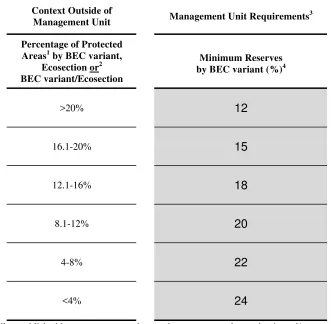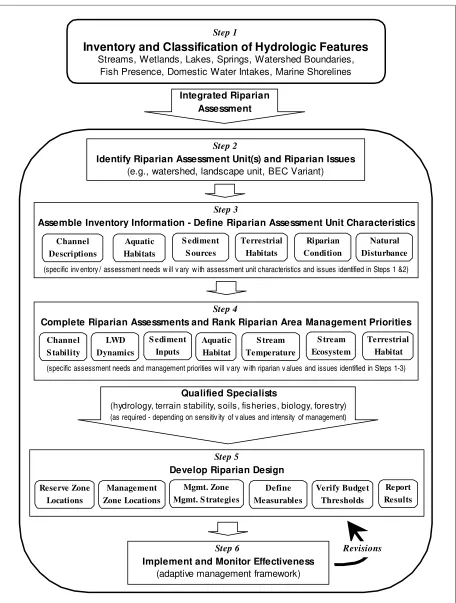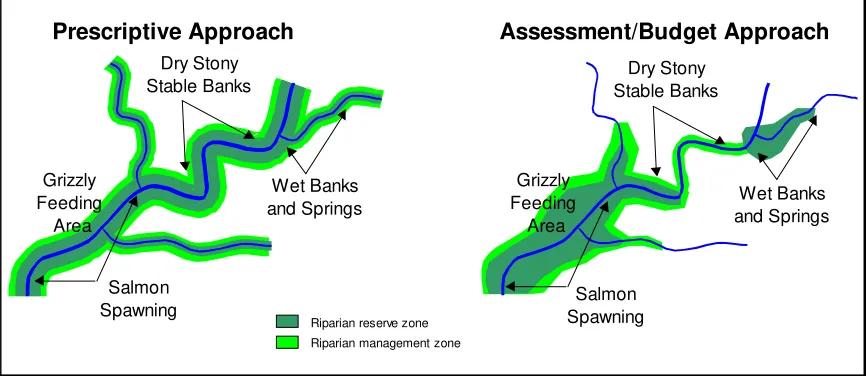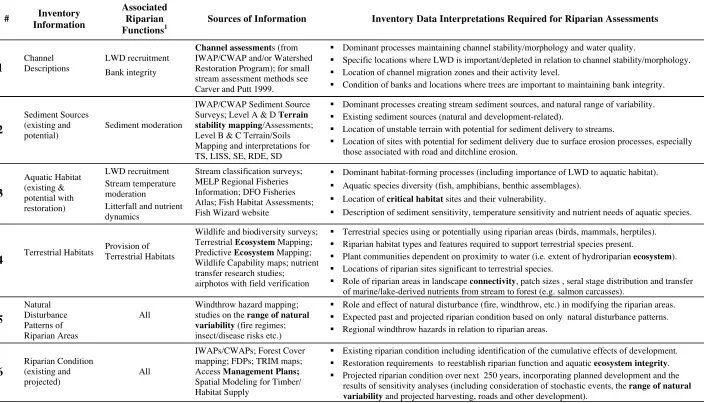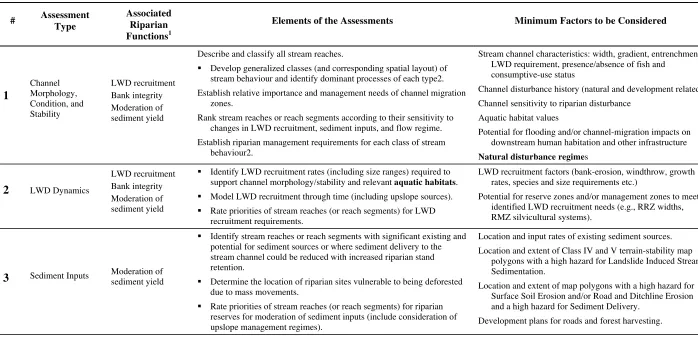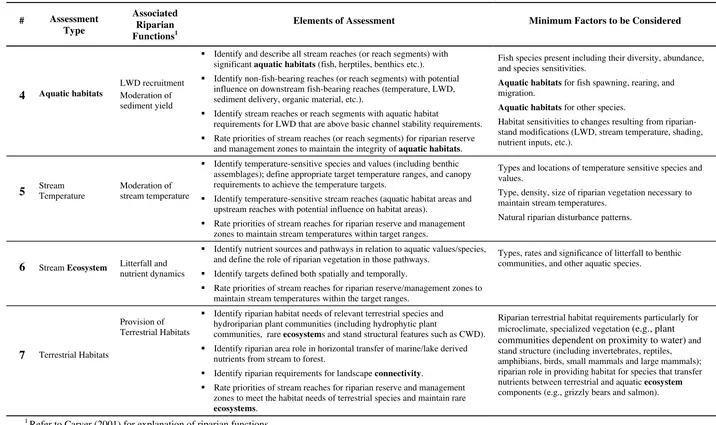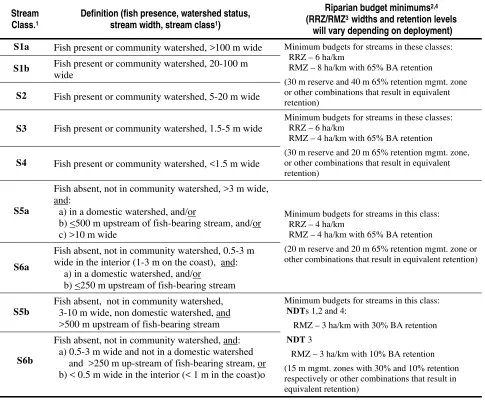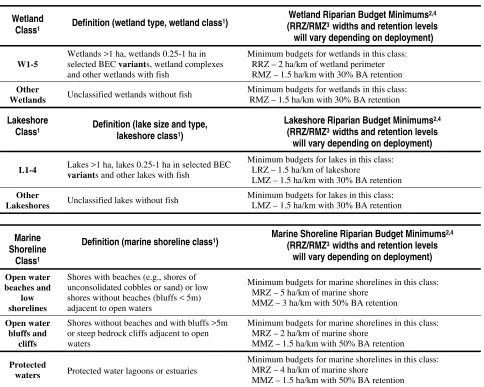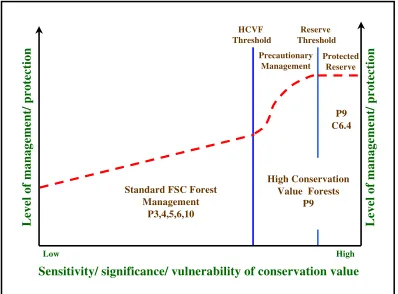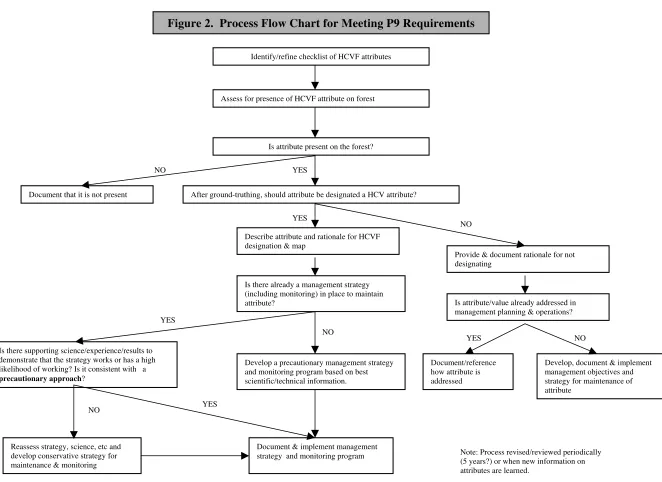Forest Stewardship Council
Regional Certification Standards
for British Columbia
Main Standards
This standard was developed by the FSC BC Regional Initiative for
Forest Stewardship Council Canada, and accredited by
FSC International in October 2005.
Questions or suggestions for revision can be sent to FSC Canada at:
400-70 The Esplanade
Toronto, Ontario M5E 1R2
Tel: 1-877-571-1133
Fax: 416-778-0044
Email:
standards@fsccanada.org
Table of Contents
Introduction ………..4
The Geographic Area Covered by these Standards ... 4
Small Operations... 4
Indicators for Compliance with FSC Principles and Criteria in British
Columbia... 5
Principle 1: Compliance with Laws and FSC Principles... 5
Principle 2: Tenure and Use Rights and Responsibilities... 9
Principle 3: Indigenous Peoples’ Rights... 13
Principle 4: Community Relations and Worker’s Rights ... 17
Principle 5: Benefits from the Forest... 22
Principle 6: Environmental Impacts ... 27
Principle 7: Management Plan... 44
Principle 8: Monitoring and Assessment ... 48
Principle 9: Maintenance of High Conservation Value Forests ... 51
Principle 10: Plantations ... 54
Appendix A: Glossary... 58
Appendix B: Requirements for Riparian Management... 83
Appendix C: Highly Hazardous Pesticides... 97
Introduction
To assist the reader, each occurrence of a defined term is bolded throughout these standards. A glossary of these terms is provided in Appendix A. Other publications referred to in the standards are listed in Appendix E.
The Geographic Area Covered by these Standards
The FSC Regional Certification Standards for B.C. are intended for application throughout the province of British Columbia, except for the portion of northern B.C. where the National Boreal Standard applies. This Boreal area is defined by the presence of the Boreal White and Black Spruce (BWBS) and the Spruce Willow Birch (SWB) biogeoclimatic zones (roughly the area within the Boreal, Sub-arctic and Sub-arctic Highlands ecodivisions (see glossary for
biogeoclimatic and ecoregional classifications). Forest management units that include land covered by the B.C. Standard and the National Boreal Standard will normally be certified with the B.C. standard, unless the area outside of the boreal region is small, in which case the National Boreal Standard is used. In case of doubt the certification body should consult with FSC Canada.
British Columbia encompasses 95 million hectares or 234 million acres (the combined size of France, Germany and the Netherlands) with relatively little development. Forests, which cover about two-thirds of the province, are central to B.C.’s way of life—not only in terms of the economy and jobs, but also for recreation, drinking water, wildlife, and spiritual values.
British Columbia is a diverse province, more variable physically and biologically than any comparable region in Canada. Broadly speaking BC is a cool, moist, mountainous, forested region with areas of semi-arid, subarctic, and alpine climates. The province has been ecologically classified into 14 biogeoclimatic zones, based on mean annual precipitation, temperature, soils and vegetation. Forests dominate the vegetation but there are also areas of grasslands, wetlands, scrub and tundra.
Because of the wide variation described above, these standards are designed for use in any type of forest or ecosystem found in the province. For this reason they require site-specific interpretation by the forest manager and by the certification body suited to the specific ecological context of each management unit.
Small Operations
FSC-BC recognizes that scale and intensity of management varies from one management unit to another. In response to those differences there are an additional set of standards that apply to small operations in BC: FSC Regional Certification Standards for BC – Small Operations Standards. Management units meeting the criteria outlined below should use that document.
Small operations are defined as:
• meet the FSC-Canada definition of Small and Low Intensity Managed Forests (i.e.
SLIMFs – management units less than 1,000 ha, OR management units that have an allowable annual cut that is <5,000m3 and less than 20% of the total mean annual increment of the productive forest area); or,
Indicators for Compliance with FSC Principles
and Criteria in British Columbia
The following sections present the Indicators required of forest managers for compliance with the FSC Principles and Criteria in British Columbia and Verifiers provided for use by
certification bodies in verifying forest managers’ compliance. Verifiers are presented as examples, and may be supplemented or replaced with other appropriate Means of Verification.
Principle 1: Compliance with Laws and FSC Principles
Forest management shall respect all applicable laws of the country in which they
occur, and international treaties and agreements to which the country is a
signatory, and comply with all FSC Principles and Criteria.
1.1
Forest management shall respect all national and local laws and
administrative requirements.
1.1.1 Up-to-date copies of applicable legislation and guidebooks are maintained by the manager
and made accessible to appropriate personnel. Electronic access is acceptable (see also FSC BC Guidance – A companion document to the FSC Regional Standards for BC – Guidance on Applicable Legislation and Guidebooks).
Intent for Criterion 1.1:
In British Columbia, laws and regulations provided by provincial, federal and municipal governments govern forest management planning and practices. Legal requirements are in flux as governments implement new policies and legislation; during auditing certifiers need to familiarize themselves with current legal and regulatory requirements that apply to the forest management unit.
The best measure of “respect for all national and locallaws” is the manager’s record of compliance with laws and regulations. Legal and regulatory measures governing forest management planning and practices anticipate non-compliance, but certification against these Standards demands a good record of compliance. These Standards require that certifiers determine what constitutes a good record of compliance by considering the following:
• Number of instances of compliance (there is not an established threshold for non-compliance, but in British Columbia a good record of compliance has routinely been measured as a compliance rate of greater than 95% with little or no significant non-compliance).
• No evidence of a pattern of recurring non-compliance.
• Evidence of corrective action including new policies implemented by the manager to avoid future non-compliance, mitigation of impacts associated with an act of non-compliance and the manager’s overall efforts to comply with laws and regulations (e.g., standard operating procedures, record keeping, worker training).
Recognizing that there is a degree of subjectivity involved in determining a good record of compliance, the Standards require certifiers to review written documentation relating to compliance and to
1.1.2 Personnel who plan and implement management activities demonstrate knowledge of legal, regulatory and administrative requirements relevant to their responsibilities.
1.1.3 A good record of compliance with applicable law relating to forest management activities is demonstrated through a review of records held by agencies responsible for enforcement or auditing of laws affecting forest management.
1.2
All applicable and legally prescribed fees, royalties, taxes and other
charges shall be paid.
1.2.1 The manager pays stumpage for the full scaled volume of all logs from each cutting authority, as shown by cruise, scale and billing information maintained by manager and/or the provincial harvest and billing database, and demonstrates that all fees, royalties, taxes or other charges have been paid in a timely way in the manner prescribed by law or contract.
1.3
In signatory countries, the provisions of all binding international
agreements such as CITES, ILO Conventions, ITTA, and Convention on
Biological Diversity, shall be respected.
1.3.1 The manager demonstrates respect for the spirit and intent of binding international agreements by:
a) maintaining copies of the agreements (electronic access is acceptable); and,
b) demonstrating familiarity and taking action consistent with those aspects of the
agreements that are relevant to operations associated with the management unit and the FSC Guidelines on the ILO Conventions (see also FSC BCGuidance – A companion document to the FSC Regional Standards for BC – Guidance onInternational
Agreements).
1.4
Conflicts between laws, regulations and the FSC Principles and Criteria
shall be evaluated for the purposes of certification, on a case by case
basis, by the certifiers and the involved or affected parties.
1.4.1 Situations where the manager's compliance with the law would preclude compliance with the FSC-BC Regional Standards, or vice versa, are documented.
1.4.2 Where a conflict is found to exist, steps are taken and documented to ensure that the FSC-BC Regional Standards are met in the present and can be met in the long term in the
management unit, including written evidence of necessary government approvals,
designations, authorizations, or exceptions/exemptions from legal requirements. Note: Any
1.5
Forest management areas should be protected from illegal harvesting,
settlement and other unauthorized activities.
1.5.1 The manager has measures in place to protect the management unit from illegal/unauthorized activities.
Means of Verification:
1.5.1 (i) Presence of specific measures to prevent unauthorized activities (e.g., boundary notices, access controls).
1.5.1 (ii) Reporting system for illegal harvesting, settlement or other unauthorized activities.
1.5.1 (iii) Reports of such activities detected during management activities.
1.5.1 (iv) Interviews with relevant personnel, to assess their familiarity with procedures for reporting unauthorized activities.
1.6 Forest managers shall demonstrate a long-term commitment to adhere to the
FSC Principles and Criteria.
1.6.1 The manager has made a publicly available, written commitment to adhere to the FSC-BC Regional Standards over the long term, which is signed off by the board of directors and/or equivalent senior authority, and included in the management plan.
Means of Verification:
1.6.1 (i) Membership in FSC.
1.6.1 (ii) Participation in standards development, review and improvement.
1.6.2 Full disclosure is made of all forest areas over which the manager has some management responsibility.
Means of Verification:
1.6.2 (i) A written strategy by the applicant to move towards managing all of its holdings in the region using a management regime that is consistent with the FSC’s Principles and Criteria (e.g., grounded in similar management philosophies, ecological frameworks, and balancing of values and objectives).
Intent for 1.6.2 and 1.6.3:
FSC does not require a forest management enterprise to apply to have all of its forest operations certified, nor to agree to a timetable for such evaluation (FSC requirements on partial certification of large ownerships). It is the goal of FSC Canada to encourage certificate holders to move towards having all of their holdings FSC certified.
Principle 2: Tenure and Use Rights and Responsibilities
Long-term tenure and forest use rights to the land and forest resources shall be
clearly defined, documented and legally established.
2.1
Clear long-term tenure and forest use rights to the land (e.g. land title,
customary rights, or lease agreements) shall be clearly demonstrated.
2.1.1 The manager has the legal right to manage the lands and to utilize the forest resources for which certification is sought, in one of the following circumstances:
a) the manager is named on the certificate of title for the area of land for which certification is sought and there are no reservations or charges that would constrain the manager’s right to manage the lands and utilize the forest resources for which certification is sought;
b) the manager has customary rights (e.g., Aboriginal title) to manage the land and utilize the forest resources in the management unit;
Intent for Criterion 2.1:
The general intent under this criteria is to specify what conditions fulfill the requirement for “clear long-term tenure and use rights to the land.” Crown-granted lands (i.e. private land) and Indian Reserve Lands clearly meet that test, assuming the registered owner or the relevant First Nation is a party to the certification application or clearly states agreement with the management plan. Crown forests in British Columbia include various types of area-based and volume based tenures. Tenures can also be short-term or long-term (generally through renewal provisions). In the case of renewable area-based
tenures (e.g., Tree Farm License, Woodlot License, Community Forest Agreement), the forest management unit and associated management responsibilities are assigned to a specific geographic area, and generally extend over long periods through repeated renewals. These are deemed to meet the test of clear long-term tenure and forest use rights to the land.
In the case of renewable long-term volume-based tenures (e.g., Forest License) a right to harvest a volume of timber is awarded to the licensee within a larger geographic area (Timber Supply Area); however, the licensee has no legal rights over any specific piece of land. In this case, the manager
must be able to demonstrate that the land-owner (i.e., the Crown) is a co-applicant to the certification, or has provided assurances that the land-owner has no objection to implementation of measures consistent with the FSC-BC standards and the manager’s management plan, and will fully incorporate the impacts of the management plan when determining an AAC for the management unit for which certification is sought. In the case of short-term non-renewable licenses (e.g., Timber Sale License) , the manager must be able demonstrate that the landowner (i.e., the Crown) is the applicant or a co-applicant for certification, as the licensee alone has no long-term management rights over the harvesting area.
In the case of volume-based tenures, and some area-based tenures (e.g., TFLs with overlapping Pulpwood Agreements), where more than one manager may have timber harvesting rights and
management responsibilities in partnership with the Crown within a defined area (e.g., a Timber Supply Area), certification of a management unit will require careful consideration by the certifier. In
c) the manager has an area-based tenure or lease that is legally eligible to be renewed or replaced over a time period sufficient to achieve the long-term management objectives set out in the management plan (e.g., the manager has a Tree Farm License, Woodlot License, Community Forest Agreement);
d) the manager has a replaceable, volume-based tenure and either the Province and the
manager jointly apply for certification, or the following requirements are met:
• at the time of initial certification, the manager demonstrates that efforts focused on the successful implementation of FSC-BC standards within the management unit, are being made with the Province and other overlapping forest tenure holders; and
• permits, licenses, plans or analyses issued and/or approved by the Province for the
management unit adhere to relevant portions of FSC-BC regional standards, the
manager’smanagement plan and supporting operational plans, and
• timber supply analysis subsequent to initial certification provides for an AAC determination specific to the management unit; or
e) the manager has a non-replaceable license, and the application for certification has been made by the manager and the province or by the Province alone.
2.1.2 A legally documented description of the lands over which the manager has rights, and for which certification is sought, including a map, is included in the management plan. In the case of a volume-based tenure, a map showing the manager's chart/operating area,
accompanied by written confirmation from the Province of the manager's rights in this area, is included.
2.1.3 Where the manager does not have title, the manager demonstrates that the owner/Province
does not impose constraints that prevent the implementation of the FSC-BC Regional Standards or the management plan in the management unit.
2.1.4 Where tenure and forest use rights in the management unit are not held by a single
manager, the management activities of other legal tenure holders do not undermine the achievement of management plan objectives or the manager has taken steps that mitigate for damages resulting from those activities.
Means of Verification:
2.1.4 (i) No evidence of activities of other tenure holders in the management unit that undermine the achievement of management plan objectives.
2.1.4 (ii) The manager has taken steps to mitigate damages resulting from such activities that may undermine the management plan objectives..
2.2
Local communities with legal or customary tenure or use rights shall
maintain control, to the extent necessary to protect their rights or
resources, over forest operations unless they delegate control with free
and informed consent to other agencies.
2.2.1 In consultation with local people, the manager identifies, documents and, where
appropriate, maps any legal or customary tenure or use rights in the management unit
held by one or more people who reside within or adjacent to it.
2.2.2 The manager:
a) obtains free and informed consent from local rights holders to any portion of the
management plan that affects their rights and resources; and,
b) if local rights holders dispute that current or proposed management protects their rights and resources, the manager implements recommendations developed through a Criterion 2.3 dispute resolution process that protect their rights and resources, to the extent that these rights are consistent with the FSC-BC Regional Standards.
2.3
Appropriate mechanisms shall be employed to resolve disputes over
tenure claims and use rights. The circumstances and status of any
outstanding disputes will be explicitly considered in the certification
evaluation. Disputes of substantial magnitude involving a significant
number of interests will normally disqualify an operation from being
certified.
2.3.1 The manager and the disputant(s) develop and implement a mutually agreed-to process to address disputes related to tenure claims and use rights.
2.3.2 To assist the mandatory consideration of disputes in the certification assessment of Criterion 2.3, the manager maintains a record of disputes and the status of their resolution, including evidence related to the dispute (whether generated internally, from outside experts or provided by disputants), and documentation of steps taken to resolve the dispute. Intent for Criterion 2.3:
The Indicators associated with this Criterion apply to a discrete set of circumstances. The certifier should pay close attention to the definitions provided in the glossary pertaining to the terms disputes, outstanding
dispute, localrights holders, local, customary rights and First Nations. These definitions are intended to clarify the scope of what is intended by disputes as they apply to tenure claims and use rights.
The certifier should pay particular attention to the efforts of all parties to resolve disputes, keeping in mind that dispute resolution requires the good faith efforts of all parties in order to succeed. The certifier should take into account circumstances where there is evidence that the manager has made a sustained effort to resolve a dispute, but other parties to the dispute have not responded to the opportunity provided.
2.3.3 The manager is not involved in outstanding disputes of substantial magnitude involving a significant number of interests in relation to the management unit. The magnitude and extent depend on various factors including the following:
a) whether the dispute involves local rights holders, localforest workers, or local
residents;
b) whether the dispute involves the legal or customary rights of First Nations;
c) the range of issues and/or interests involved;
d) whether the potential impacts on the disputant(s) are irreversible or cannot be mitigated; and /or
Principle 3: Indigenous Peoples’ Rights
The legal and customary rights of indigenous peoples to own, use and manage
their lands, territories and resources shall be recognised and respected.
3.1
Indigenous peoples shall control forest management on their lands and
territories unless they delegate control with free and informed consent to
other agencies.
Intent for Criterion 3.1:
The Standards direct the certifier to assess the relationship between the manager and the relevant First Nation(s). This relationship forms the basis for addressing the requirement of Criterion 3.1 relating to “free and informed consent.” The relationship should clearly demonstrate whether the manager recognizes and respects the customary and legal rights of First Nations over their lands, territories and resources. See the glossary for a definition of lands, territories and resources.
While the Constitution and case law affirm Aboriginal Rights and Title, the lands, territories and resources to which rights and title are associated overlap with Crown ownership and the rights of Crown tenure holders. The process of determining where Aboriginal Rights and Title apply is a matter of negotiation between the Crown and First Nations (e.g., Treaty Process) and the outcome of litigation. A Crown tenure holder—for the purpose of these Standards the manager—has a different role from that of the Crown in relation to a demonstration of respect and recognition for Aboriginal Rights and Title.
These Standards do not address the relationship between First Nations and the Crown, but that between the manager and relevant First Nations. The Standards define the relationship between the
manager and First Nations in terms of respect and recognition, and the interplay between consent and control as related to the management plan and operations on the management unit. The Standards set out a number of ways the existence of these elements can be determined. The tests in this case, are not a measure of the degree of respect and recognition, but whether all of these elements are apparent in the relationship, along with the effort made by the manager to consult with and accommodate the interests of relevant First Nations.
During an assessment certifiers need to take into account the following:
• Agreements between the relevant First Nation(s) and the manager that address the requirements of the Standards may be in writing or otherwise apparent. It can be anticipated that the exact form of an agreement, formal or informal, will vary depending on circumstances and the decision-making practices of individual First Nations.
• If during an assessment it is determined that, notwithstanding the efforts of the manager, relevant First Nation(s) have decided not to participate in measures that address the requirements of the Standards, this circumstance should be evaluated and taken into consideration by the certifier. The certifier should clearly distinguish between cases where the First Nation(s) are not participating because of dissatisfaction with management activities on the management unit or the manager, and a lack of interest or capacity to participate.
• Under no circumstances should certification proceed in the face of dissatisfaction of the affected First Nation(s) regarding management activities within the Management Unit.
Indicators of Recognition and Respect
3.1.1 The managerrecognizes and respects the legal and customary rights of the First Nation(s) over their lands, territories and resources.
Means of Verification:
3.1.1 (i) First Nation(s) formally indicate clearly and unambiguously, either verbally or in writing, that their legal and customary rights over their lands, territories and resources have been recognized and respected.
3.1.1 (ii) First Nation(s) interests or concerns are clearly incorporated in the management plan.
3.1.2 If requested by a relevant First Nation(s), a protocol agreement(s) has been reached that provides for the nature of the relationship between the parties, including:
a) How the parties will establish and conduct their relationship;
b) The roles and responsibilities of the parties;
c) The interests of the parties;
d) A description of appropriate decision-making authorities for all parties; and,
e) Provides the framework for subsequent agreements necessary to give effect to the protocol.
3.1.3 Where a dispute arises the manager makes available an effective and fair resolution process to address the dispute as outlined under Criterion 4.5.
Indicators of Consent and Control
3.1.4 The manager has obtained free and informed consent, normally in writing, for the
management plan from the appropriate First Nation(s) after either: Intent for Criterion 3.1 (cont’d):
• Claims to traditional territory made by more than one First Nation occasionally overlap
geographically. In some cases overlapping claims are subject to protocol agreements or similar mechanisms between the relevant First Nations, while in others the overlap remains an open question. Where an overlapping claim occurs, it is beyond the ability of the manager to adjudicate or otherwise resolve this issue. Certifiers will have to consider this circumstance when it arises on a case-by-case basis, looking for agreements between relevant First Nations and efforts made by the manager in response to the circumstance.
• Where the land and/or traditional territories of more than one First Nation (i.e., discrete from overlapping claims) fall within the management unit being certified, the certifier will, as directed by the Standards, assess the relationship between the manager and each First Nation.
Application of the Standards are without prejudice to treaty, land claims settlements, or agreements First Nations may reach with government. The Standards shall not be construed as an acceptance of Provincial Crown title or extinguishment of Aboriginal title. The Standards do not derogate from the
a) jointly developing the plan according to the process set out in a joint management agreement, or,
b) consulting with the First Nation(s) on the plan.
Means of Verification:
3.1.4 (i) Evidence of oral or written consent.
3.1.4 (ii) The relevant First Nation has the financial, technical and logistical capacity to enable them to participate on an informed basis in planning and decision-making.
3.1.5 Conditions under which consent has been given and under which it might be withdrawn, if any, are recorded in the management plan.
3.1.6 Where more than one First Nation is affected by the area being proposed for forestry activities, consent from each is ordinarily required.
Means of Verification:
3.1.6 (i) The manager has contacted all relevant First Nation(s).
3.1.6 (ii) Evidence of written or oral consent.
3.1.6 (iii) Where there are adjacent or overlapping areas, or shared territories, the manager has an ongoing relationship, based on mutual respect, with those First Nations(s) that have close ties to the area of the management unit (e.g., First Nations’ communities within close proximity, have present activities within the management unit, have historical occupancy, traditional uses or traditional place names within the management unit, etc.).
3.2
Forest management shall not threaten or diminish, either directly or
indirectly, the resources or tenure rights of indigenous peoples.
3.2.1 Forest management activities within the management unit are planned and implemented in such a way as to maintain the resources and tenure rights of the First Nation(s), except in the following circumstances:
a) the First Nation(s) are satisfied with measures to offset the loss or diminishment (e.g., restoration, replacement, monetary compensation, or other consideration); or,
b) the First Nation(s) agree to accept the loss or diminishment.
3.3
Sites of special cultural, ecological, economic or religious significance to
indigenous peoples shall be clearly identified in cooperation with such
peoples, and recognised and protected by forest managers.
3.3.1 Forest management activities within the management unit are planned and implemented in such a way as to protect sites of special cultural, ecological, economic, or religious
significance to the First Nation(s) except in the following circumstances:
b) the First Nation(s) agree to accept the loss or diminishment.
3.4
Indigenous peoples shall be compensated for the application of their
traditional knowledge regarding the use of forest species or management
systems in forest operations. This compensation shall be formally agreed
upon with their free and informed consent before forest operations
commence.
3.4.1 Where mutually agreed, the manager incorporates First Nation(s)traditional knowledge
into the management plan and supporting operational plans and practices.
Principle 4: Community Relations and Worker’s Rights
Forest management operations shall maintain or enhance the long-term social
and economic well being of forest workers and local communities.
Intent for Principle 4:
The applicant should be a responsible corporate citizen and ensure forest workers on the
management unit are treated fairly, with respect and dignity, and use their influence to persuade contractors, subcontractors and over-lapping license holders to do the same. Responsible corporate citizenship for the purposes of Principle 4 is interpreted as:
• ensuring that local communities receive an equitable share of economic and social benefits from the extraction and processing of forest products from the management unit,
• ensuring that those adversely affected by management activities on the management unit are treated fairly; and,
• consulting with local and/or affected communities and the public (see glossary definition of “directly affected persons” and intent for Criterion 4.4. below), regarding their concerns with management activities on the management unit, and accommodating those concerns.
While consultation and consent from First Nations is expected to be a distinct process from public participation under Principle 4, this Principle otherwise applies equally to Indigenous communities and its interpretation should take into account issues that are often especially relevant in Indigenous communities, such as a shortage of capacity and resources.
Local communities and forest workers should be interpreted based on the definitions of “local,” “forest worker” and “employee” supplied in the FSC-BC glossary. Under this Principle, some
indicators are directed towards the employees of the applicant, whereas others are directed at forest workers. Note that "forest worker" is a more comprehensive term than is “employee”. Forest workers include the employees of contractors, overlapping or third-party licensees, as well as
employees of the applicant or applicant entity. Both union and non-union workers are included. The requirements that can be applied to a contractor or overlapping or third-party license holder are somewhat limited by legal requirements, but in some cases, such as provision of disability and accident insurance, the applicant is required to remedy any deficiencies that may be present in the terms of employment offered by contractors and third-party licensees.
The manager’s policies to encourage local hiring should include benchmarks (e.g., local employees
as a percentage of total employees, today and x years from now), and measures within the
manager’s control to address potential barriers to employment on the management unit for groups currently underrepresented in the workforce, where this is identified as an issue through consultation.
It is recognized that sources of all goods and services may not presently be available locally, but the
manager is expected to demonstrate that concrete steps are being taken to increase the amount of goods and services obtained locally; for example:
• setting the date, location, terms and specifications for bidding so that local suppliers and contractors may readily bid;
• giving local suppliers/businesses a right of first refusal on contracts for the supply of goods and services;
• eliminating corporate policies that preclude the use of local suppliers of goods and services;
4.1
The communities within, or adjacent to, the forest management area
should be given the opportunity for employment, training and other
services.
Employment
4.1.1 Localforest workers are employed on the management unit.
Means of Verification:
4.1.1 (i) Written policies that encourage local hiring and evidence that such policies are being implemented.
4.1.1 (ii) Local forest workers as percentage of total forest workers.
4.1.1 (iii) Percentage of contracted activities captured by local companies or individuals.
4.1.2 Wages and benefits paid to forest workers are consistent with regional BC industry average.
Means of Verification:
4.1.2 (i) Manager’s and contractor’s records relating to wages paid and benefits provided to forest workers.
4.1.2 (ii) BC industry averages from BC Statistics.
4.1.3 The manager requires contractors to adhere to portions of the FSC-BC Regional Standards relevant to their activities on the management unit.
Training
4.1.4 The manager and contractors provide training opportunities and/or collaborate with local
training providers and institutions, such that:
a) local people receive enhanced employment qualifications;
b) forest workers receive the training needed to comply with the FSC-BC Regional Standards and legal requirements applicable to their responsibilities; and,
c) employees receive skills upgrading to facilitate advancement within the manager's operations.
Means of Verification:
4.1.4 (i) A documented skills development, training and professional development policy and program.
4.1.4 (ii) Interviews with forest workers, union officers, contractors, First Nations, local community members and any institutions providing skills upgrading in the area.
Goods and Services
4.1.6 The manager utilizes local goods and services.
Means of Verification:
4.1.6 (i) Policies and processes related to local procurement.
4.1.6 (ii) Tender notices.
4.1.6 (iii) Evidence of local procurement (e.g., contracts with local suppliers, lists of purchases).
4.2
Forest management should meet or exceed all applicable laws and/or
regulations covering health and safety of employees and their families.
4.2.1 The manager develops and implements a safety program (for all forest workers) to meet orexceed occupational health and safety regulations. The program includes:
a) assessing new forest practices for hazards and developing/communicating appropriate safety measures in relation to them, and
b) ensuring that forest workers are informed about potential health and safety risks, including provision of full information about the right to refuse work and the contents of
chemicals used.
Means of Verification:
4.2.1 (i) Interviews with forest workers, and union officers.
4.2.2 The manager's operations have a consistently low accident frequency rate.
Means of Verification:
4.2.2 (i) Workers Compensation Board records and confidential forest worker interviews verify the accident history on the management unit (manager's and contractor’s).
4.2.2 (ii) Forest worker interviews indicate that the manager’s safety program enhances worker safety and is implemented consistently and fairly.
4.3
The rights of workers to organize and voluntarily negotiate with their
employers shall be guaranteed as outlined in conventions ‘87 and ‘98 of
the International Labour Organization.
4.3.1 The manager's actions demonstrate support for the rights of forest workers to organize and voluntarily negotiate collective agreements. The manager adheres to labour/employment and human rights practices that protect forest workers from discrimination or harassment (e.g. , whistle blower protection, etc.).
Means of Verification:
4.3.2 Managers/contractors comply with applicable labour laws and collective agreements.
Means of Verification:
4.3.2 (i): Labour relations board/grievance records, and interviews with forest workers and union officers.
4.4
Management planning and operations shall incorporate the results of
evaluations of social impact. Consultations shall be maintained with
people and groups (both men and women) directly affected by
management operations.
4.4.1 The manager develops and implements a plan for ongoing public participation that accommodates the needs and preferences of directly affected persons in relation to the process.
4.4.2 Directly affected persons are provided with information used in making management decisions in a manner that allows them to understand potential impacts on their rights or interests, including reasonable technical or expert interpretation as required.
4.4.3 Consistent with the FSC-BC Regional Standards, steps to protect the rights or interests of
directly affected persons are developed and agreed to through the public participation process, and implemented by the manager.
4.4.4 Where the manager and directly affected persons fail to reach agreement through the public participation process, a mutually agreed-to dispute resolution process is used as outlined under Criterion 4.5.
Intent for Criterion 4.4:
In British Columbia 95% of the commercial forest is publicly (Crown) owned, and private forest ownership, where it occurs, usually encompasses values important to the public. This means that the public has an interest in the management of forestland and that forest management benefits from public involvement because:
• People have a right to be meaningfully involved in decisions affecting them, especially when those activities are being carried out on publicly owned (Crown) lands;
• Interested and affected parties have knowledge and expertise – especially pertaining to local conditions – that can help improve the plan and the resulting forestry operations; and,
• Forest management planning that is adequately informed by the views of affected people is more likely to be politically acceptable and socially beneficial to affected communities.
4.5
Appropriate mechanisms shall be employed for resolving grievances and
for providing fair compensation in the case of loss or damage affecting
the legal or customary rights, property, resources, or livelihoods of local
peoples. Measures shall be taken to avoid such loss or damage.
4.5.1 Grievances involving potential loss or damage related to the manager’s forestry activities are resolved through a process mutually agreed to by the manager and the grievor(s).
Means of Verification:
4.5.1 (i) Manager’s records of grievances
4.5.2 (ii) Interviews with local people.
4.5.2 Where a local person or people have provided the manager with a grievance notice, the
manager takes actions to resolve the grievance, for example:
a) in the case of a grievance involving potential loss or damage related to the manager's forestry activities, the manager refrains from carrying out the activity(ies) until: a) the
manager satisfies the grievor(s) that the activity(ies) will not cause loss or damage; or, b) effective measures are in place to protect the grievor(s) from the potential loss or damage set out in the grievance notice; or,
b) in the case of a grievance based on evidence that the manager is responsible for actual loss or damage affecting the grievor(s)’ rights, property, resources or livelihoods, the
manager provides the compensation (e.g., financial payment, restoration), if any, required to place the grievor(s) in the position that they would have been but for the activities of the manager, as agreed to by the parties or determined through arbitration.
4.5.3 The manager documents steps taken to resolve grievances, including evidence related to proof of loss or damage and amount of compensation, whether generated internally, or provided by outside experts or the grievors.
4.5.4 Where a grievance results in arbitration, the costs of arbitration payable by the parties are determined by mutual agreement or, failing agreement, by the arbitrator(s), on the basis of the facts of the case, including the good faith of the parties and the parties’ ability to pay.
4.5.5 Where it is determined, either by agreement or arbitration, that the manager is responsible for loss or damage to a grievor(s)’ rights, property, resources or livelihood, the manager has measures in place to protect the grievor(s) from future loss or damage due to the manager’s activities.
Intent for Criterion 4.5:
Principle 5: Benefits from the Forest
Forest management operations shall encourage the efficient use of the forest's
multiple products and services to ensure economic viability and a wide range of
environmental and social benefits.
5.1
Forest management should strive toward economic viability, while taking
into account the full environmental, social, and operational costs of
production, and ensuring the investments necessary to maintain the
ecological productivity of the forest.
5.1.1 The management plan and supporting operational plans describe activities in sufficient detail to enable costs of implementation to be credibly estimated.
5.1.2 The manager's ability to implement the management plan, including investments necessary to maintain the ecological productivity of the forest and provisions to manage for other forest values, is confirmed by business plans and other relevant documents.
5.1.3 The management plan and/or supporting documents include information (quantitative when available) that demonstrate how environmental costs (e.g., greenhouse gases, waste disposal, noise pollution) and social costs (i.e., identified through local assessments and public consultation) associated with management activities have been considered. The
documentation also includes information on what measures have been taken to offset, reduce or eliminate such costs.
5.1.4 When making investment and operational decisions, the manager sets benchmarks for reducing social and environmental costs over time and meets these benchmarks.
5.2
Forest management and marketing operations should encourage the
optimal use and local processing of the forest's diversity of products.
Local processing
5.2.1 The manager makes available a diversity of forest products from the management unit to
local processors, at prevailing market rates, or at prices that cover the manager's opportunity costs.
Means of Verification:
5.2.1 (i) Interviews with local processors regarding opportunities the manager provides them for enhancing their business.
Optimal use
Means of Verification:
5.2.2 (i) Forest product sales records.
5.2.2 (ii) Interviews with value-added processors and competitive log markets in the area.
5.2.2 (iii) Management plan objectives related to optimizing value of forest products.
5.2.3 The manager evaluates different options for enhancing the optimal use of forest products from the management unit and implements measures to achieve optimal use.
5.3
Forest management should minimize waste associated with harvesting
and on-site processing operations and avoid damage to other forest
resources.
5.3.1 The manager takes measures to minimize wood waste. The minimization of waste does not interfere with the requirements for coarse woody debris and snags as set out under Indicator 6.3.8.
5.3.2 While felling, skidding/yarding, bucking, sorting and handling, the manager takes steps to avoid breakage and damage while optimizing log utilization, grade and value.
5.3.3 While harvesting forest products, the manager takes steps to avoid damage to the residual stand, other ecosystem components, and special features.
5.4
Forest management should strive to strengthen and diversify the local
economy, avoiding dependence on a single forest product.
5.4.1 A diversity of timber and non-timber forest products, compatible with site conditions and
local economic objectives for strengthening and diversifying the local economy over time, are produced at present, and predicted to continue under management plan forecasts.
Means of Verification:
5.4.1 (i) Interviews with forest-dependent businesses and local people regarding the manager’s record of adjusting forest management practices to accommodate strengthening and diversifying the management unit’s contribution to the local economy from non-timber forest uses, fish and wildlife.
5.4.2 In response to interest from the local community, the manager evaluates existing and potential production of non-timber forest products within the management unit, and identifies and implements forest management practices that produce a diversity of non-timber forest products compatible with site conditions and local objectives for
strengthening and diversifying the local economy over time.
Means of Verification:
5.4.2 (ii) Interviews with local timber and non-timber forest product companies regarding cooperation by the manager in economic diversification.
5.5
Forest management operations shall recognize, maintain, and, where
appropriate, enhance the value of forest services and resources such as
watersheds and fisheries.
5.5.1 The manager identifies ecosystem services provided by the management unit, drawing on existing information (e.g., relevant assessments, inventories, studies) and public consultation as applicable.
5.5.2 The manager assesses and describes existing and potential impacts of forest management
activities on ecosystem services.
5.5.3 The manager identifies and implements measures required to maintain or enhance the range of ecosystem services provided by the management unit.
Means of Verification:
5.5.3 (i) Interviews with local people regarding whether ecosystem services have been adequately maintained.
5.6
The rate of harvest of forest products shall not exceed levels which can
be permanently sustained.
Intent of Criterion 5.6:
In British Columbia, the allowable annual cut (AAC) for Crown forest tenures are determined by the provincial Chief Forester, and generally revisited every five years. Timber supply analyses are completed by tenure holders (i.e. the managers) according to BC Ministry of Forests’ specifications, and then submitted to the Chief Forester for determination of an AAC. The Chief Forester’s
determination is based on a number of factors, as defined in provincial legislation and policy (including information on standing timber inventories, site productivity, timber availability, current management practices, potential losses due to fire, insects or disease, as well as social and economic
considerations).
AAC determinations for area-based Crown tenures are for specific management units (e.g. Tree Farm Licenses), and are generally compatible with the approach outlined in Indicator 5.6.1. For volume-based tenures in BC, AACs are determined for individual Timber Supply Areas (TSAs) which normally include a number of licenses. An application for FSC certification based on a single volume-based license that constitutes only a portion of a TSA would normally require a separate timber supply analysis that specifically addresses the land area for which certification is being sought (i.e. only a portion of a TSA). However, assumptions about management practices for the FSC management unit
within the Ministry of Forests’ TSA timber supply review process should also be consistent with the FSC management plan for that area. AAC calculations for private lands seeking certification should also be completed in a manner that meets the requirements of Criterion 5.6.
5.6.1 The rate of timber harvest for the management unit is based on a documented and comprehensive analysis, incorporating the following:
a) the management objectives and strategies for the full range of forest resources as set out in the management plan, including those for restoration;
b) practices employed to implement the strategies and operational approaches in the
management plan, including those for restoration;
c) up-to-date inventories and the best available growth-and-yield data and projections;
d) land base reductions to account for areas that are reserved or unavailable for harvest due to economic or operational limitations;
e) volume reductions to account for stand level retention and recruitment for ecosystem
components such as snags, wildlife trees and coarse woody debris;
f) non-recoverable losses such as those resulting from fires, insects and disease; and,
g) reductions required to protect non-timber values and forest-dependent economic activities.
5.6.2 The rate of timber harvest is determined in a manner that adequately reflects reliability and uncertainty associated with inventory data, management assumptions, growth-and-yield projections, and analysis methodologies.
Mean of Verification:
5.6.2 (i) Sensitivity analyses are undertaken to examine the potential timber supply impacts of uncertainties in data, growth projections and management assumptions
5.6.2 (ii) Where sensitivity analysis indicates potentially significant impacts on timber supply, an adequate margin of safety is included when setting the rate of harvest.
5.6.3 Where the manager harvests or has the ability to control the harvest of non-timber forest products, the manager assures that the rate of harvest reflects the best available inventory and productivity data, provides for sustainable production, and is adjusted when monitoring indicates over-harvesting.
5.6.4 The manager demonstrates that the average of the present and projected annual timber harvests over the next decade, and averages of projected timber harvests over all subsequent decades, do not exceed the projected long-term harvest rate, while meeting the FSC-BC Regional Standards over the long term.
Intent for Criterion 5.6 (cont’d):
The intent of Criterion 5.6 is to ensure that the process of timber supply analysis and AAC
5.6.5 After ten years of FSC certification, the manager demonstrates that the decadal averages of actual timber harvests in decades subsequent to FSC certification have not exceeded the projected long-term harvest rate. (Note: This indicator only applies in a Recertification)
5.6.6 Actual rate of timber harvest in any given year is no more than 25% above the projected long-term harvest rate, unless:
a) the manager has harvested an equivalent amount below the projected long-term harvest level within the last ten years and subsequent to FSC certification;
b) the management unit has a long-term annual harvest level less than 10,000 m3; or,
c) the manager can demonstrate that an elevated harvest rate is planned to address
Principle 6: Environmental Impacts
Forest management shall conserve biological diversity and its associated values,
water resources, soils, and unique and fragile ecosystems and landscapes, and,
by so doing, maintain the ecological functions and the integrity of the forest.
6.1
Assessment of environmental impacts shall be completed - appropriate to
the scale, intensity of forest management and the uniqueness of the
affected resources - and adequately integrated into management
systems. Assessments shall include landscape level considerations as
well as the impacts of on-site processing facilities. Environmental
impacts shall be assessed prior to commencement of site-disturbing
operations.
Inventory
(see also FSC BC Guidance – A companion document to the FSC Regional Standards for BC)
6.1.1 Based on the best available information, the manager assembles relevant inventory data to establish the regional and landscape level context for environmental impact assessment (see
FSC BC Guidance), including at a minimum:
a) biogeoclimatic ecosystem classification(BEC) mapping to the variant level for all
ecosections which occur within the management unit;
b) percentage of Protected Areas by BEC variant and ecosection for the BEC units and
ecosections that occur within the management unit (to a level below BEC variant
where available); and,
c) extent and intensity of land use in surrounding portions of relevant BEC variants and
ecosections.
6.1.2 The manager collects and/or assembles reconnaissance level inventory information appropriate for landscape level planning and completion of a management plan for the
management unit as a whole, including at a minimum:
a) natural disturbance regime;
b) list of potentially occurring native species (including at a minimum indicator plants,
focal species, and other species of concern); and,
c) mapping of forest cover, BEC units to the variant level, hydrologic features,
reconnaissance terrain stability mapping, cultural features, visual sensitivity, land use and other tenures.
a) terrain and soil conservation hazard mapping;
b) forest cover;
c) ecological classification to a level below the BEC variant (e.g., site series PEM/TEM), where required for habitat assessments for focal species or other species of concern;
d) distribution of seral stages and patch sizes, including non-forest types;
e) watershed condition, including hydrologic features present and specific indicators of hydrologic risk (e.g., channel assessments, present and projected equivalent clearcut area - ECA, extent of human-induced riparian disturbance, road density);
f) biodiversity information including focal species and their habitats; and
g) where access-sensitive species or their habitats are present (e.g., grizzly bears, ungulate winter range), assessments to determine measures for the protection of those species and habitats.
6.1.4 In areas proposed for road construction, timber harvesting, and/or other treatments that will likely affect water quality (e.g., fertilization) or stream channel integrity, detailed maps of
hydrologic features, including riparian classification, are completed in advance of
initiating management activities. The maps include identification of fish-bearing streams and domestic and irrigation water sources.
6.1.5 Where road construction or timber harvesting is proposed for areas rated with a moderate or high likelihood of landslides, areas rated as high or very high erosion potential, areas upslope of such hazardous areas (i.e. "gentle over steep"), or recharge areas for springs with domestic or irrigation water users; detailed terrain assessments and/or detailed hydrologic assessments are completed to assess the risks to the environment and provide
recommendations on mitigation or other measures to reduce risk (e.g., drainage plans).
6.1.6 In areas proposed for timber harvesting, prior to preparing stand level prescriptions and selecting harvesting methods, inventories at the cutblock or stand level are completed, including at a minimum:
a) stand structure, including occurrence of live wildlife trees and snags, and relative amounts of coarse woody debris ;
b) presence of aquatic habitats, rare ecosystem features and/or other critical habitats identified at the site level; and,
c) basic ecosystem and soil information.
Risk/Impact Assessments
(see also FSC BC Guidance – A companion document to the FSC Regional Standards for BC)
6.1.7 Based on the best available information, the manager prepares a written description of the estimated range of natural variability including reference to ecosystem conditions and
ecosystemfunctioning (see FSC BC Guidance – Guidance on RONV). This description serves as an environmental base case (i.e. benchmark or reference ecosystem conditions) against which to measure potential environmental changes or impacts resulting from proposed management activities.
6.1.7 (i) Documentation of the methodology, assumptions and information used to define the range of natural variability.
6.1.7 (ii) Updates to the range of natural variability description as new information becomes available.
6.1.8 As part of the management planning process, an environmental risk assessment is completed, by comparing present and projected ecosystem conditions on the management unit to the range of natural variability (i.e.. "natural"). Increasing risk is defined as increasing deviation from natural. The risk assessment is appropriate to the scale and intensity of management activities, and the sensitivity of the affected ecosystems. (See FSC BC Guidance - Guidance on RONV and Risk Assessment).
Inventory and Assessments Guide Management
6.1.9 The manager demonstrates that management planning and operational implementation are based on inventory information and the results of terrain stability mapping, soil
conservation hazard assessments, hydrologic assessments, habitat assessments and access-sensitive species assessments
6.1.10 Where an assessment completed under Indicator 6.1.8 indicates that environmental impacts of proposed management activities pose significant risk to biodiversity or other environmental values, then:
a) management activities do not occur; or,
b) the manager reduces the risk to a level comparable to that under RONV by employing an alternative management approach and/or mitigation measures; or,
c) the manager provides a written rationale that includes evidence the chosen option will not compromise ecosystem integrity in the broader context.
6.2
Safeguards shall exist which protect rare, threatened and endangered
species and their habitats (e.g. nesting and feeding areas). Conservation
zones and protection areas shall be established, appropriate to the scale
and intensity of forest management and the uniqueness of the affected
resources. Inappropriate hunting, fishing, trapping and collecting shall be
controlled.
6.2.1 Habitats of red- and blue-listed species and plant communities (as defined by the BC Conservation Data Centre) and threatened species and endangered species, and species of special concern (as defined by the Committee on the Status of Endangered Wildlife in Canada) within a management unit are identified by field surveys or other means, and delineated on maps, subject to confidentiality requirements (see 7.4.1).
6.2.2 Where there are existing or potential habitats of red-listed, blue-listed, endangered or
threatened species, or species of special concern, or red- or blue-listed plant communities present on the management unit, the manager demonstrates measures are in place on the
a) protecting those habitats and/or plant communities by including them in the protected reserve network;
b) avoiding habitat alteration that may result in increased risk to those species' and/or plant communities' long-term persistence; and/or,
c) where necessary, restoring those habitats and/or plant communities to a suitable condition.
Means of Verification:
6.2.2(i) Where population information is available, it demonstrates that the population levels of applicable species have not decreased or failed to increase, due to the manager's activities within the management unit.
6.2.2(ii) Where habitat modeling for applicable species has been undertaken, it shows that proposed future management activities are not expected to contribute to increased risk to the species or limit recovery options.
6.2.3 Where a government recovery plan or species management plan has been prepared for a red- or blue-listed, threatened or endangered species, species of special concern or red- or blue-listed plant community whose habitat occurs within a management unit, the manager
is implementing the recovery or species management plan. While recovery or species
management plans are under development, the manager takes steps that are within his or her control to facilitate survival and recovery of the species or plant community.
6.2.4 The manager has training programs, standard operating procedures and/or protocols that specify measures for dealing with unexpected encounters with red- and blue-listed,
threatened and endangered species, and species of special concern, or their habitats during operational activities. Field staff are aware of these measures. When these species or habitats are encountered, prompt notification is made to personnel who are capable of implementing prescriptions and practices designed to protect and promote the survival and recovery of the species, and these practices are implemented.
6.2.5 The manager cooperates with the government authorities to prevent the harming, harassing, capturing or taking of red- or blue-listed species, threatened or endangered species, or species of special concern within the management unit.
6.3 Ecological
functions
and values shall be maintained intact, enhanced, or
restored, including:
a) Forest regeneration and succession.
b) Genetic, species, and ecosystem diversity.
c) Natural cycles that affect the productivity of the forest ecosystem.
Intent for Criterion 6.3:
6.3.1 If there are portions of the management unit where previous management activities have resulted in conditions that are inconsistent with the FSC-BC standards (i.e. areas of poorly managednatural forests or former plantations), these have been designated restoration areas, and it is evident that activities are planned and being implemented to restore those areas to conditions that are consistent with FSC-BC requirements.
a) Forest regeneration and succession
6.3.2 Regeneration surveys confirm that successful and ecologically appropriate regeneration is occurring on disturbed forest lands.
Intent for Criterion 6.3 (cont’d):
variability (RONV) as the benchmark against which to guide or assess management targets (using information developed through 6.1.2 and 6.1.7, see FSC BC Guidance - Guidance on Applying RONV
to Forest Management).
Key to this is an analysis of whether current and proposed future states are ‘compatible with RONV’, which entails being within RONV, moving towards RONV, or providing evidence that functions and values are being maintained now and into the future.
Within 6.3, areas of focus are separated into Regeneration and Succession, Genetic, Species and Ecosystem Diversity, and Productivity.
Stand and landscape level characteristics are dealt with primarily but not solely in the ‘Diversity’ section:
6.3.1 asks for an assessment of restoration requirements, and requires development of prescriptions for restoring attributes. This indicator applies at all scales, as required by the current condition of the
management unit.
Indicators 6.3.2 to 6.3.6 focus on regeneration, maintaining tree diversity during regeneration treatments, site preparation and the maintenance of early seral herb and shrub communities in relation to RONV.
6.3.7 and 6.3.8 ask for an assessment of the current and predicted future extent to which
management results in stand types and stand level attributes that are compatible with RONV. Stand level attributes are the focus, but both stand and landscape level scales are refereed to, which captures the concept that these values vary at different scales; stand level averages may have more or less variability in different landscapes. In addition to considering RONV, minimum levels for retention are specified in 6.3.9, and are required because a) management never fully mimics natural disturbance and typically results in considerably higher removal of biomass from the site than do most natural disturbances and b) natural disturbance typically do not cease with the onset of management so harvesting is often in addition to continuing natural disturbances rather than replacing natural events.
6.3.10 focuses on landscape level parameters of seral stage distribution and patch size to ensure they are and remain compatible with RONV. 6.3.11 and 12 focus on other critical landscape level parameters, particularly connectivity and access management. 6.3.13 ensures the maintenance or restoration of unique features and non-forested ecosystems.
